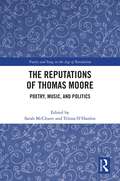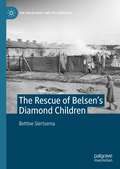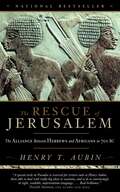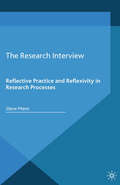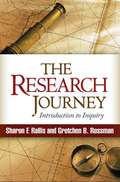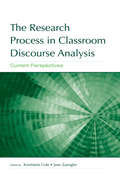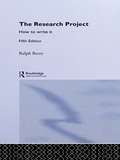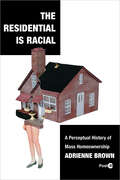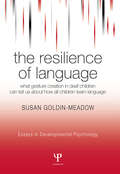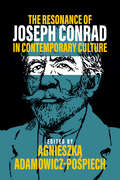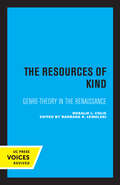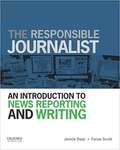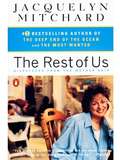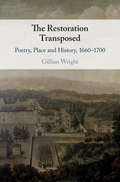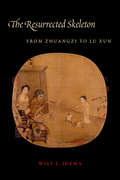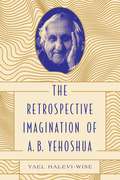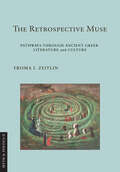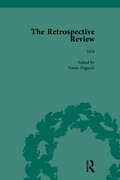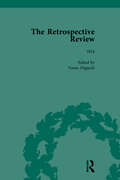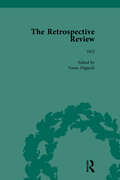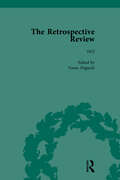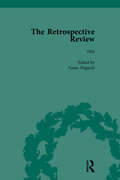- Table View
- List View
The Reputations of Thomas Moore: Poetry, Music and Politics (Poetry and Song in the Age of Revolution)
by Sarah McCleave Triona O'HanlonThis collection of eleven essays positions Moore within a developing and expanding international readership during the course of the nineteenth century. In accounting for the successes he achieved and the challenges he faced, recurring themes include: Moore’s influence and reputation; modes of dissemination through networks and among communities; also, the articulation of personal, political, and national identities. This book, the product of an international team of scholars, is the first to focus explicitly on the reputations of Thomas Moore in different parts of the world, including Bombay, Dublin, Leipzig, and London, as well as America, Canada, Greece, and the Hispanic world. Through it, we will understand more about Moore’s reception, and also appreciate how the publication and dissemination of poetry and song in the romantic and Victorian eras operated in different parts of the world—in particular considering how artistic and political networks effected the transmission of cultural products.
The Rescue Dogs
by Jessica QuiltyThe fun and excitement of English and Language Arts learning continues in Grade 2 of Reading Street. This comprehensive and dynamic curriculum for homeschooling is geared toward young children who have some foundational English and Language Arts knowledge and are ready to strengthen their skills. Comprised of engaging activities, challenging content and weekly quizzes, Reading Street: Grade 2 is the next step in your child's path toward becoming a lifelong learner and reader. As with all Reading Street products, the Grade 2 system is formatted to help students meet certain age-appropriate goals. After completing this English and Language Arts homeschool program, your child should be able to: Read and comprehend two-syllable words. Identify common prefixes (such as pre-, un-, or re-) and suffixes (such as -able, -ad and -er). Correct mistakes made when reading out loud. Read books with two or more chapters. Understand the structure of stores (i. e. beginning, middle and end). Start selecting reading materials based on his/her own interests. Identify the "who," "what," "when," "where," "why" and "how" of the text. While the goals of second Grade English and Language Arts are numerous, Reading Street will help you craft engrossing lessons. Your child will garner important English and Language Arts skills while completing a workbook, reading stories and poems, and taking assessments. Planning these lessons will be easier than ever, as all Reading Street systems are broken down into weekly Big Ideas. All the work your child does on a given week is formulated around that single concept for an organized and challenging curriculum. With six easy-to-follow units, Reading Street: Grade 2 is the perfect tool for homeschooling parents. Your child will enjoy the reading selections and activities, and you'll love to see your student growing into a knowledgeable individual. We're confident that this product is the right one for you. For more information on the specific materials found in Grade 2 of Reading Street, check out the Features and Benefits page.
The Rescue of Belsen’s Diamond Children (The Holocaust and its Contexts)
by Bettine SiertsemaThis book uncovers the history of a group of Jewish workers and merchants in the Amsterdam diamond industry during the Holocaust. They and their families were exempt from deportation for a long time, but were eventually deported to Bergen-Belsen. In the end, almost all of the men perished, and the women barely survived slave-labour. Their children were left to die in the camp, but were miraculously saved by the intervention of a Jewish Polish woman, ‘nurse Luba’. The main sources on which this book is based are video testimonies of the surviving members of this group, personal interviews, minutes of interviews taken down in shorthand shortly after the war, and personal documents such as letters, archival documents, and autobiographical books.
The Rescue of Jerusalem: The Alliance Between Hebrews and Africans in 701 BC
by Henry AubinIn 701 BC, the powerful Assyrian army laid siege to Jerusalem, threatening the Hebrew kingdom with destruction. What saved the City of David? The Bible credits divine intervention. Modern scholars have long speculated that a plague spread through the ranks of the Assyrian soldiers, forcing them to withdraw.Now, in this ground-breaking account, award-winning author Henry Aubin argues that it was the Kushites, the black Africans who formed Egypt’s 25th dynasty, who saved Jerusalem, the birthplace of Judaism, Christianity and Islam. In his powerful, wide-ranging analysis, Aubin shows how Western scholarship turned its back on the theory of black African involvement.The account of the long-forgotten African and Hebrew alliance that rescued Jerusalem will change the face of Jewish and African history and contribute to a fresh understanding of our world today.
The Research Interview: Reflective Practice and Reflexivity in Research Processes
by S. MannResearch and Qualitative Interviews brings into focus the decisions that the interviewer faces by taking a data-led approach in order to open up choices and decisions in the process of planning for, managing, analysing and representing interviews. The chapters concentrate on the real-time, moment-by-moment nature of interview management and interaction. A key feature of the book is the inclusion of reflexive vignettes that foreground the voices and experience of qualitative researchers (both novices and more expert practitioners). The vignettes demonstrate the importance of reflecting on and learning from interactional experience. In addition, the book provides an overview of different types of interviews, commenting on the orientation and make-up of each type. Overall, this book encourages reflective thinking about the use of research interviews. It distinguishes between reflection, reflective practice and reflexivity. All the chapters focus on recurring choices, dilemmas and puzzles; offering advice in opening out and engaging with these aspects of the research interview.
The Research Journey: Introduction to Inquiry
by Sharon Rallis Gretchen Rossman Thomas SchwandtDesigned to foster "inquiry-mindedness," this book prepares graduate students to develop a conceptual framework and conduct inquiry projects that are linked to ongoing conversations in a field. The authors examine different ways of knowing and show how to identify a research question; build arguments and support them with evidence; make informed design decisions; engage in reflective, ethical practices; and produce a written proposal or report. Each chapter opens with a set of critical questions, followed by a dialogue among five fictional graduate students exploring questions and concerns about their own inquiry projects; these issues are revisited throughout the chapter. Other useful features include end-of-chapter learning activities for individual or group use. Useful pedagogical features include: *Framing questions for exploration and reflection. *Chapter-opening dialogues that bring in perspectives from multiple disciplines. *Example boxes with detailed cases and questions for the reader. *End-of-chapter activities and experiential exercises that guide readers to develop their own inquiry projects. *Suggestions for further reading.
The Research Process in Classroom Discourse Analysis: Current Perspectives
by KimMarie Cole • Jane ZuenglerThis volume gives intellectual space to a range of current perspectives on classroom discourse research and provides a forum for conversations about the research process. Classroom discourse researchers from different theoretical perspectives provide five separate analyses of the same instructional unit in a high school biology class, using the same set of data. Interwoven with the five research reports are several conversations among the editors and researchers regarding specific aspects of the research process. These conversations illuminate some of the actual decisions that researchers make when looking at data and crafting their analyses. This book is intended for graduate students, researchers, and teacher educators across the fields of applied linguistics and education who are interested in studying classroom discourse and, more generally, language-in-use. With its focus on both the research process and the outcomes of research, as well as on the theory-method relationship, this book is relevant for courses in research methodology, language in education, applied linguistics, discourse analysis, language development, and multiculturalism in the classroom.
The Research Project: How to Write It
by Ralph BerryNow in its fifth edition, this guide to project work continues to be an indispensable resource for all students undertaking research.Guiding the reader right through from preliminary stages to completion, The Research Project: How to write it sets out in clear and concise terms the main tasks involved in doing a research project, covering:* choosing a topic* using the library effectively* taking notes* shaping and composing the project* providing footnotes, documentation and a bibliography* avoiding common pitfalls.Fully updated throughout, this new edition features a chapter on making the most out of the Internet, from knowing where to start, to assessing the quality of the material found there. Other features include a model example of a well researched, clearly written paper with notes and bibliography and a chapter on getting published in a learned journal for more advanced researchers.Whether starting out or experienced in research, The Research Project: How to write it is an essential tool for success.
The Residential Is Racial: A Perceptual History of Mass Homeownership (Post*45)
by Adrienne BrownHousing experts and activists have long described the foundational role race has played in the creation of mass homeownership. This book insistently tracks the inverse: the role of mass homeownership in changing the definition, perception, and value of race. In The Residential is Racial Adrienne Brown reveals how mass homeownership remade the rubrics of race, from the early cases realtors made for homeownership's necessity to white survival through to the 1968 Fair Housing Act. Reading real estate archives and appraisal textbooks alongside literary works by F. Scott Fitzgerald, John Steinbeck, Lorraine Hansberry, Richard Wright, Gwendolyn Brooks, James Baldwin, Ralph Ellison, John Cheever, and Thomas Pynchon, Brown goes beyond merely identifying the discriminatory mechanisms that the real estate industry used to forestall black homeownership. Rather, she reveals that redlining and other forms of racial discrimination are perceptual modes, changing what it means to sense race and assign it value. Resituating residential discrimination as a key moment within the history of perception and aesthetics as well as of policy, demography, and democracy, we get an even more expansive picture of both its origins and its impacts. This book discovers that the racial honing of perception on the block—seeing race like a bureaucrat, an appraiser, and a homeowner—has become central to the functioning of the residential itself.
The Resilience of Language: What Gesture Creation in Deaf Children Can Tell Us About How All Children Learn Language (Essays in Developmental Psychology)
by Susan Goldin-MeadowImagine a child who has never seen or heard any language at all. Would such a child be able to invent a language on her own? Despite what one might guess, the children described in this book make it clear that the answer to this question is 'yes'. The children are congenitally deaf and cannot learn the spoken language that surrounds them. In addition, they have not yet been exposed to sign language, either by their hearing parents or their oral schools. Nevertheless, the children use their hands to communicate - they gesture - and those gestures take on many of the forms and functions of language. The properties of language that we find in the deaf children's gestures are just those properties that do not need to be handed down from generation to generation, but can be reinvented by a child de novo - the resilient properties of language. This book suggests that all children, deaf or hearing, come to language-learning ready to develop precisely these language properties. In this way, studies of gesture creation in deaf children can show us the way that children themselves have a large hand in shaping how language is learned.
The Resonance of Joseph Conrad in Contemporary Culture
by Agnieszka Adamowicz-PośpiechA hundred years after his death, the life and legacy of the Polish-British novelist Joseph Conrad remains deeply felt in a wide range of global cultural contexts. The Resonance of Joseph Conrad in Contemporary Culture brings together scholars of wide-ranging backgrounds to provide a holistic assessment of the afterlife of Conrad’s work. Ranging from Conrad’s influence upon contemporary writers, to the impact of his translators and his adaptation within film and graphic novels, this volume illuminates how Conrad’s approach to questions of moral ambiguity and the haunting complexities of colonialism continues to inform the cultural output of our modern, globalized world.
The Resources of Kind: Genre-Theory in the Renaissance (Una's Lectures #1)
by Rosalie ColieThis title is part of UC Press's Voices Revived program, which commemorates University of California Press’s mission to seek out and cultivate the brightest minds and give them voice, reach, and impact. Drawing on a backlist dating to 1893, Voices Revived makes high-quality, peer-reviewed scholarship accessible once again using print-on-demand technology. This title was originally published in 1973.
The Responsible Journalist: An Introduction to News Reporting and Writing
by Jennie Dear Faron ScottThe Responsible Journalist: An Introduction to News Reporting and Writing teaches reporting and writing skills from a liberal arts perspective with the understanding that at its heart, journalism is about public service. The text presents journalism as an approach--one that involves careful thought, ethical decision-making, skepticism, an attention to accuracy and an emphasis on truthfulness.
The Responsive Writer
by Jocelyn SilerI've based the formal writing assignments in The Responsive Writer on the subjects of writing and placed the critical thinking, critical reading and research .
The Rest of Us: Dispatches from the Mother Ship
by Jacquelyn MitchardThe author of the bestselling The Deep End of the Ocean and the acclaimed The Most Wanted offers her clear-eyed takes on the complexities of everyday life--assembled from her syndicated column, The Rest of Us.
The Restoration Transposed: Poetry, Place and History, 1660–1700
by Gillian WrightThis revisionist study of Restoration literature and culture demonstrates how important the decades between 1660 and 1700 were in transforming, enlarging and diversifying English-language poetry. Wright challenges the longstanding narrative of Restoration poetry as a male, urban, London-centric form obsessed with the contemporary, arguing persuasively that this schema omits crucial literary works and relationships. Framed around three detailed case studies of neglected aspects of Restoration poetry, the book explores the depth of Spenser's influence, the importance of poetry flourishing in Ireland, the significance of natural landscapes and the vital role of women: both as readers, and writers. This book presents a diverse literary Restoration steeped in historical self-awareness and anxieties, engaged with the world outside England's capital, and open to new voices. Its impressive scope encompasses myriad little-known writers, while extensive historical research underpins its fresh perspectives on poets such as Dryden, Rochester, Cowley, Milton, Marvell and Behn.
The Resurrected Skeleton: From Zhuangzi to Lu Xun (Translations from the Asian Classics)
by Wilt IdemaThe early Chinese text Master Zhuang (Zhuangzi) is well known for its relativistic philosophy and colorful anecdotes. In the work, Zhuang Zhou ca. 300 B.C.E.) dreams that he is a butterfly and wonders, upon awaking, if he in fact dreamed that he was a butterfly or if the butterfly is now dreaming that it is Zhuang Zhou. The text also recounts Master Zhuang's encounter with a skull, which praises the pleasures of death over the toil of living. This anecdote became popular with Chinese poets of the second and third century C.E. and found renewed significance with the founders of Quanzhen Daoism in the twelfth century.The Quanzhen masters transformed the skull into a skeleton and treated the object as a metonym for death and a symbol of the refusal of enlightenment. Later preachers made further revisions, adding Master Zhuang's resurrection of the skeleton, a series of accusations made by the skeleton against the philosopher, and the enlightenment of the magistrate who judges their case. The legend of the skeleton was widely popular throughout the Ming dynasty (1368–1644), and the fiction writer Lu Xun (1881–1936) reimagined it in the modern era. The first book in English to trace the development of the legend and its relationship to centuries of change in Chinese philosophy and culture, The Resurrected Skeleton translates and contextualizes the story's major adaptations and draws parallels with the Muslim legend of Jesus's encounter with a skull and the European tradition of the Dance of Death. Translated works include versions of the legend in the form of popular ballads and plays, together with Lu Xun's short story of the 1930s, underlining the continuity between traditional and modern Chinese culture.
The Retrospective Imagination of A. B. Yehoshua (Dimyonot)
by Yael Halevi-WiseOnce referred to by the New York Times as the “Israeli Faulkner,” A. B. Yehoshua’s fiction invites an assessment of Israel’s Jewish inheritance and the moral and political options that the country currently faces in the Middle East. The Retrospective Imagination of A. B. Yehoshua is an insightful overview of the fiction, nonfiction, and hundreds of critical responses to the work of Israel’s leading novelist.Instead of an exhaustive chronological-biographical account of Yehoshua’s artistic growth, Yael Halevi-Wise calls for a systematic appreciation of the author’s major themes and compositional patterns. Specifically, she argues for reading Yehoshua’s novels as reflections on the “condition of Israel,” constructed multifocally to engage four intersecting levels of signification: psychological, sociological, historical, and historiosophic. Each of the book’s seven chapters employs a different interpretive method to showcase how Yehoshua’s constructions of character psychology, social relations, national history, and historiosophic allusions to traditional Jewish symbols manifest themselves across his novels. The book ends with a playful dialogue in the style of Yehoshua’s masterpiece, Mr. Mani, that interrogates his definition of Jewish identity.Masterfully written, with full control of all the relevant materials, Halevi-Wise’s assessment of Yehoshua will appeal to students and scholars of modern Jewish literature and Jewish studies.
The Retrospective Imagination of A. B. Yehoshua (Dimyonot: Jews and the Cultural Imagination #9)
by Yael Halevi-WiseOnce referred to by the New York Times as the "Israeli Faulkner," A. B. Yehoshua’s fiction invites an assessment of Israel’s Jewish inheritance and the moral and political options that the country currently faces in the Middle East. The Retrospective Imagination of A. B. Yehoshua is an insightful overview of the fiction, nonfiction, and hundreds of critical responses to the work of Israel’s leading novelist.Instead of an exhaustive chronological-biographical account of Yehoshua’s artistic growth, Yael Halevi-Wise calls for a systematic appreciation of the author’s major themes and compositional patterns. Specifically, she argues for reading Yehoshua’s novels as reflections on the "condition of Israel," constructed multifocally to engage four intersecting levels of signification: psychological, sociological, historical, and historiosophic. Each of the book’s seven chapters employs a different interpretive method to showcase how Yehoshua’s constructions of character psychology, social relations, national history, and historiosophic allusions to traditional Jewish symbols manifest themselves across his novels. The book ends with a playful dialogue in the style of Yehoshua’s masterpiece, Mr. Mani, that interrogates his definition of Jewish identity.Masterfully written, with full control of all the relevant materials, Halevi-Wise’s assessment of Yehoshua will appeal to students and scholars of modern Jewish literature and Jewish studies.
The Retrospective Muse: Pathways through Ancient Greek Literature and Culture (Myth and Poetics II)
by Froma I. ZeitlinThe Retrospective Muse showcases the celebrated work of Froma I. Zeitlin. Over many decades, Zeitlin's innovative studies have changed the field of classics. Her instantly recognizable work brings together anthropology, gender studies, cultural studies, and an acute literary sensibility to open ancient texts and ideas to new forms of understanding. A selection of her luminous essays on topics still timely today are collected for the first time in a volume that shows the full range and flair of her remarkable intellect. Together, these illuminating analyses show why Zeitlin's work on ancient Greek culture has had an enduring impact on scholars around the world, not just in classics but across multiple fields. From Homer to the Greek novel, from religion to erotics, from myth and ritual to theatrical performance, she expounds on some of the most important works of ancient writing and some of modernity's most significant critical questions. Zeitlin's writing still sheds light on the durable aspects of classics as a discipline, and this book encapsulates her achievement.
The Retrospective Review Vol 1
by Yasuo DeguchiFounded in 1820 by Henry Southern, "The Retrospective Review" aimed to recall the public from an exclusive attention to new books, by making the merit of old ones the subject of critical discussion. This edition reproduces in facsimile all 18 volumes of the periodical published between 1820-1854.
The Retrospective Review Vol 10
by Yasuo DeguchiFounded in 1820 by Henry Southern, "The Retrospective Review" aimed to recall the public from an exclusive attention to new books, by making the merit of old ones the subject of critical discussion. This edition reproduces in facsimile all 18 volumes of the periodical published between 1820-1854.
The Retrospective Review Vol 11
by Yasuo DeguchiFounded in 1820 by Henry Southern, "The Retrospective Review" aimed to recall the public from an exclusive attention to new books, by making the merit of old ones the subject of critical discussion. This edition reproduces in facsimile all 18 volumes of the periodical published between 1820-1854.
The Retrospective Review Vol 12
by Yasuo DeguchiFounded in 1820 by Henry Southern, "The Retrospective Review" aimed to recall the public from an exclusive attention to new books, by making the merit of old ones the subject of critical discussion. This edition reproduces in facsimile all 18 volumes of the periodical published between 1820-1854.
The Retrospective Review Vol 13
by Yasuo DeguchiFounded in 1820 by Henry Southern, "The Retrospective Review" aimed to recall the public from an exclusive attention to new books, by making the merit of old ones the subject of critical discussion. This edition reproduces in facsimile all 18 volumes of the periodical published between 1820-1854.
